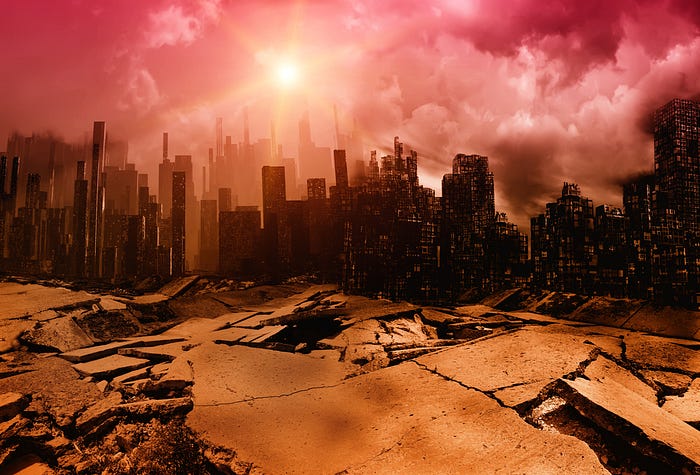Understanding the Environmental and Health Impact of Earthquake Debris
Written on
Chapter 1: The Nature of Earthquakes
Earthquakes are natural occurrences triggered by the sudden movement of tectonic plates. While many extreme weather events, like floods and droughts, are linked to climate change, earthquakes arise from geological forces. These tectonic plates can remain stationary for extended periods due to friction, but when the pressure builds up enough, they shift suddenly. As our continents continue to drift, earthquakes will remain a natural phenomenon.
To better understand this, check out the following time-lapse video showcasing plate movements over time:
The severity of earthquakes can vary greatly, as indicated by the Richter scale. Mild tremors may go unnoticed, while more powerful earthquakes can wreak havoc. Here’s a brief overview of earthquake magnitudes and their potential impacts:
- < 2.5: Typically imperceptible; occur millions of times annually.
- 2.5–5.4: Felt but cause minor damage; approximately 500,000 annually.
- 5.5–6.0: May cause slight structural damage; around 350 occurrences yearly.
- 6.1–6.9: Significant damage, especially in populated regions; about 100 each year.
- 7.0–7.9: Major destruction; occurs 10-15 times a year.
- > 8.0: Catastrophic destruction in nearby areas; happens once every one or two years.
Each year, over 100 earthquakes result in serious damage, leaving behind vast amounts of debris.
Section 1.1: Understanding Earthquake Debris
Earthquake debris consists of remnants from collapsed or unstable structures and can be categorized into various types:
- Household items (e.g., furniture, clothing)
- Appliances (e.g., ovens, refrigerators)
- Electronics (e.g., TVs, computers)
- Vehicles (e.g., cars, trucks)
- Hazardous materials (e.g., batteries, chemicals)
- Building materials (e.g., bricks, concrete)
- Vegetation (e.g., trees, shrubs)
- Organic waste (e.g., spoiled food)
- Animal remains (e.g., pets, livestock)
- Natural earth materials (e.g., soil, rocks)
The extent of debris generated is influenced not only by the earthquake's magnitude but also by local building codes and construction quality. For instance, the catastrophic earthquake in Turkey on February 6, 2023, registered at a magnitude of 7.8, leading to the collapse of tens of thousands of structures due to inadequate building practices.
Subsection 1.1.1: The Importance of Sustainable Management
Effective debris management is crucial for recovery, focusing on essential infrastructure like hospitals and roads first, followed by other affected areas. Sustainable management involves not just debris removal but also sorting, recycling, and ensuring public health safety.

Chapter 2: Environmental and Health Risks
Dealing with earthquake debris poses several environmental and health risks, including dust, heavy metals, and putrescibles.
The first video titled "Covering Your Health: Earth Day & Recycling" provides insights into managing hazardous materials and recycling efforts, especially in the context of natural disasters.
One significant risk arises from dust generated by debris and collapsed structures, particularly asbestos. While once commonly used in construction due to its durability, asbestos dust poses severe health risks, contaminating air, water, and soil. When inhaled, these fine fibers can lead to serious respiratory issues, including lung cancer.
Another source of dust comes from landslides, which can carry harmful spores such as Coccidioides immitis, responsible for valley fever. Symptoms may vary from mild to severe, requiring medical intervention for some individuals.
The second video, "Surviving the Quake," explores the aftermath of earthquakes and the importance of preparedness in minimizing health risks.
Tsunami sludge is another concern, composed of water, debris, and sediment that can introduce chemicals and heavy metals into the environment, leading to chronic respiratory illnesses.
Heavy metals and chemicals from debris can contaminate water sources, adversely affecting aquatic ecosystems and human health. Long-term exposure may lead to conditions such as Parkinson's disease.
Putrescibles, or organic materials, can decay without proper management, leading to bacteria and mold growth. This increases the risk of foodborne illnesses and attracts pests that may carry diseases.
Disrupted sanitation after an earthquake creates breeding grounds for pests and can lead to the spread of infectious diseases like cholera and leptospirosis, further complicating recovery efforts.
Conclusion: Taking Action
Earthquake debris poses significant threats to both the environment and public health, from airborne dust and chemical contamination to sanitation issues. To mitigate these risks, individuals can:
- Prevent asbestos from breaking during cleanup.
- Dispose of hazardous materials appropriately.
- Wear protective gear while handling debris.
- Follow earthquake building regulations.
- Collaborate on debris management strategies.
By implementing these practices, we can help limit the negative impacts of earthquake debris on our health and environment.
Did you find this article helpful? If so, you might enjoy Dr. Erlijn van Genuchten's book, "A Guide to A Healthier Planet," which offers further insights into environmental sustainability.
About the Author
Dr. Erlijn van Genuchten is a renowned expert in environmental sustainability and science communication, dedicated to helping others apply scientific knowledge for a healthier planet. Her work, including support for the United Nations and her YouTube channel, has inspired many to take action for a sustainable future.